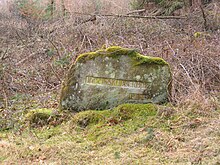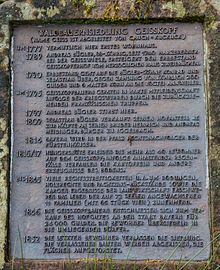Geisskopf farm ruin
| Geißkopf farm ruin | ||
|---|---|---|
 Geißkopf farm ruin |
||
| Data | ||
| place | Elmstein | |
| Client | Counts of Leiningen, Pfalz-Zweibrücken | |
| Architectural style | Silvicultural settlement | |
| Construction year | 1744 | |
| demolition | 1852 | |
| Coordinates | 49 ° 18 '45 " N , 7 ° 55' 31" E | |
|
|
||
The Geisskopf farm ruin (also Geiskopfhof ruin , Geiskopferhof ) is a submerged forest farming settlement south of Iggelbach ( Elmstein municipality ).
history
The forest area around the Geiskopf originally belonged to the Lower Franconian Pasture . Around 1300 it was owned by the Counts of Leiningen , as was the Falkenburg near Wilgartswiesen , which was built to protect the Lower Franconian Pasture. After frequent changes of tenure, the area was then jointly owned by the Counts of Leiningen and the Duke of Zweibrücken for centuries . Immediately to the south and southwest of the area joined the Haingeraide .
This common ownership was repeatedly the cause of disputes between the two houses, which mainly concerned the income from the valuable oak and beech stocks in the area around the Geiskopf. The forest was monitored from Wilgartswiesen , the seat of the Liningian officials. Due to the great distance, these controls were very incomplete, so that theft of wood and game could take place undisturbed and herders from the grove brought their cattle to graze in the forest . In order to put a stop to the forest iniquity, the leiningisch-Zweibrücken rulers decided to give the area at the Geiskopf in temporal inventory (= temporary lease). As a result, negotiations were held with those willing to build a courtyard to be built there.
On July 15, 1732 Friedrich Zeiss, got common man and Müller from Albersweiler , the area (about 9 morning meadows and about 10-12 morning yet cleared is arable land on the plateau, as well as smaller meadow areas in the lower valley portions) to 20 years in Temporal lease. Since the available arable and meadow areas were insufficient to feed his family, he was allowed to build a sawmill in addition to his house and stables . This was built at the foot of the Geiskopf, in the valley on the Geiswiese (270 m above sea level), at the confluence of the Geisbach and Blattbach . Over the next few years, for unknown reasons, the inventory was transferred to the Oberschultheißen Wendel Metzger from Albersweiler. The Geiskopf itself remained uninhabited.
In 1744, the communal rulers decided to build another farm above the Geiswieserhof on the Geiskopfer plateau (390 m above sea level), which was then inherited (= leasing for at least 25 years, mostly for life, with the right to inheritance ) the biological offspring) should be given. The following points were given:
- Around 150 acres of forest could be converted into arable land.
- The lard and rough pasture in the entire forest district of Geiskopf had to be given to the stand.
- Due to the lack of meadows on the plateau, the stand would have to receive the valley meadows after the temporal stand on the Geiswieserhof expired.
- The Geiswieserhof with the sawmill was to be added to the new courtyard after the temporal structure had expired.
- The construction timber should be provided and the use of firewood limited to fallen and cleared wood.
- The cleared areas and fields should now be free of tithes , and the exemption of all other facilities should be retained in the previous extent.
- The stock should receive the common fishing rights with the neighboring Haingeraiden (medieval cooperative forests) and the Palatinate .
- Ultimately, the herd should be left to hunt, since the game population on the Geiskopf is already low due to the proximity of largely released forests.
The survey carried out in 1748 showed a total area of the temporary stock of 517 acres, of which 9 acres were meadows, 1 acre house, courtyard and garden area and 8 acres were arable land.
In 1752 the sawmill stock on the Geiswiese came to an end. But since there was still no applicant for the entire Geiskopf in sight, the previous operator of the Sägmühle (Wendel Metzger) agreed to operate the mill until a tenant was found for the Geiskopf.
On May 29, 1759, the entire Geiskopf was on fire. Of the buildings on Geiswiese, only the sawmill was spared the fire. It was thought that wood thieves started the fire. Because of this event, the community of Leiningen-Zweibrücken finally decided to inherit the Geiskopf. First, however, on March 16, 1770, the Sägmühl inventory on Geiswiese was auctioned again. Leonhard Bügler, son of Andreas Bügler, who has lived on the Geiswiese since 1740, took over the sawmill, the house, which was poorly repaired after the forest fire, as well as fields and meadows. Since there was nothing to be earned with the sawmill, which had since collapsed and had become dilapidated, in 1772 he was allowed to convert it into a small barn. The lordly owners took over the costs of 111 guilders . Furthermore, ironers were allowed to burn resin on the Geiskopf.
From February 1777 there were two new applicants - Michael Matz and Konrad Schäfer, both from Rinnthal - for the Geiswiese. A contract for 12 years was signed with the two. During this time, the first house was probably built on the Geiskopf and the clearing of the forest began. Presumably one of the tenants already lived on the Geiskopf. After the lease ended in 1789, both applicants moved away again.
On June 23, 1789, the Geiskopf was inherited for the first time. Since the temporal inventory on the Geiswiese expired in the same year, it was added to the hereditary inventory on the Geiskopf. The bidder was 88-year-old Andreas Bügler, who had thus achieved his long-awaited goal of being a leaseholder on the Geiskopf. Now it was important for his sons and their descendants to maintain the farm and, if possible, to expand it. Bügler had already had a few fields and meadows laid out in a valley widening in the Grobsbach valley to the east. Around 1795, the Hornesselwieserhof (250 m above sea level) was built there as a settlement area, which is still in existence today in a modified form as the “ Silent Valley ” forest restaurant . Andreas Bügler died on the Geiskopf on August 29, 1797 at the age of 96.
Also in 1789 the French Revolution broke out. French troops occupied the entire Palatinate in the following years , the nobility and clergy lost their possessions. Heavy fights at Johanniskreuz and at Schänzel also affected the Geiskopf farmers. As a result of the fighting, the farmers and their people had to endure heavy strain, especially on December 13, 1795, when the French withdrew under General Michel Reneauld . After the First Peace of Paris in 1814, the Palatinate became part of Bavaria and the former stately forests became state forests . The forest farms Geiskopf and Geiswiese remained with their respective owners.
Due to bad harvests in 1816 and 1817, a great famine followed . Meanwhile over 40 people lived on the Geiskopf, who had been badly hungry and for whose food the available arable land was insufficient. Therefore, they demanded from the Palatinate government in Speyer that the rights to the allocation of 180 to 200 acres of land enshrined in the long-term lease are fulfilled. Long-term processes followed, some of which were ended in a settlement .
For a long time the farm farmers opposed the state intended to purchase all goods. But under the pressure of the increasingly poor economic conditions, the sale took place on November 20, 1845. In the course of the following year, most of the Geiskopf residents (now over 70 people) moved to the surrounding villages such as Elmstein , Appenthal , Iggelbach , Hofstätten , Rinnthal , Dernbach and Eusserthal . The last residents of the farm followed in 1852. The forest authorities demolished the buildings and the entire area was afforested.
In a 1985 study on the former deserted farms in the Palatinate Forest , Christoph Jentsch , Klaus Hünerfauth and Dieter Kreye were able to present detailed results for the first time on the Geiskopferhof. According to the original cadastre from 1838, the Geiskopferhof hereditary holdings at that time comprised an area of 58.19 days 'work , the area of the Geiswieserhof was 3.55 days' work. Furthermore, the location of the individual buildings and a map of the Geiskopferhof were created in reconstruction attempts.
geography
The forest district Geiskopf (467 m) is located in the Middle Palatinate Forest , in the Palatinate Forest-Vosges du Nord biosphere reserve south of the forest village Iggelbach belonging to the municipality of Elmstein , between the Hofberg (371 m) in the north and the Erdbirnkopf (506 m) in the south the border of the Bad Dürkheim district and the independent city of Landau in the Palatinate .
traffic
The access to the former Geiskopferhof is via the B 39 ( Speyer - Kaiserslautern ) at Frankeneck on the L 499 (Frankeneck - Johanniskreuz ) at Helmbach on the K 51 (Helmbach - Helmbachweiher ) from Helmbachweiher on the K 18 (Helmbachweiher - Waldgaststätte Stilles Tal ) at Waldgaststätte Hornesselswiese, continue on a paved forest road to the Geiswiese car park.
Waters
The Geiskopf is framed by three brooks: in the west by Teufelsbach and Geißbach (4.19 km), in the north by Helmbach (11.04 km) and in the east by Grobsbach (4.35 km).
literature
- Arnold Ruby: Elmstein in the Palatinate Forest Nature Park and its surroundings. The rise and fall of the forest farming settlement on the Geiskopf. Edeldruck, Lambrecht 1971.
- Karl Heinz Himmler: Geißkopf. History of a lost forest farming settlement near Iggelbach. Local community and tourist office Elmstein, Elmstein 1991.
- Walter Eitelmann: Knight Stones in the Palatinate Forest. A stone historiography Palatinate Forest Association, Neustadt 1998, ISBN 3-00-003544-3 .
- Christoph Jentsch , Klaus Hünerfauth, Dieter Kreye: The farms in the upper Helmbach valley. Reprint from: Reports on German regional studies , issue 2, year 1989.
- Klaus Hünerfauth: The Geiskopferhof near Iggelbach. In: Members' magazine of the Palatinate Forest Association , number 3/1996.
- Only old stones are reminiscent of the forgotten courtyard. In: Mittelhaardter Rundschau , No. 195 from August 25, 1986.



